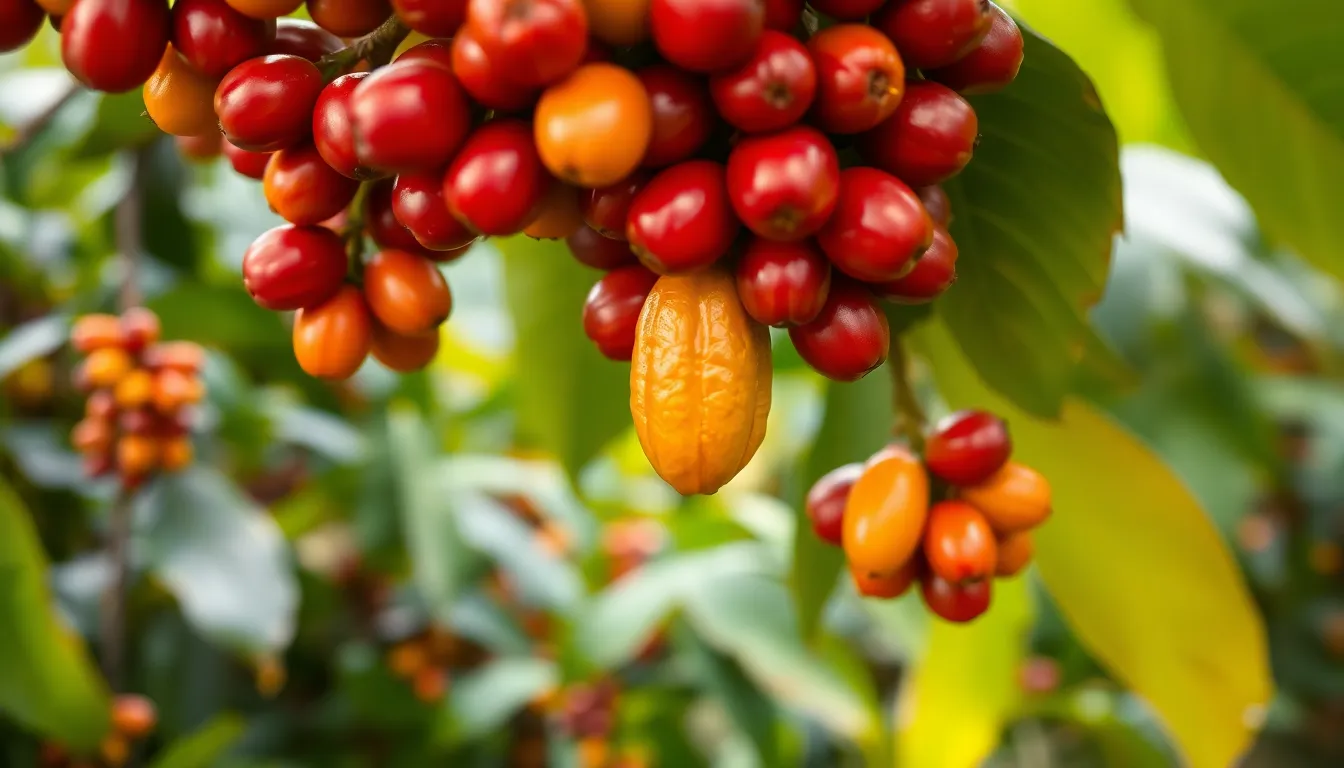Have you ever wondered how fermenting coffee beans can transform your morning brew into something extraordinary? This ancient processing method isn’t just a step in coffee production—it’s an art form that significantly impacts flavor development and complexity.
When you ferment coffee beans, natural microorganisms break down the sugary mucilage surrounding the beans, creating unique flavor profiles impossible to achieve through other methods. From the bright, fruity notes in Ethiopian varieties to the chocolate undertones in Brazilian beans, fermentation plays a crucial role in developing those distinctive tastes that coffee enthusiasts crave. Discovering how different fermentation techniques affect your coffee might just revolutionize your daily ritual.
What Is Coffee Fermentation?
Coffee fermentation is a biochemical process where natural microorganisms break down the sugary mucilage surrounding coffee beans after harvesting. This crucial step transforms raw coffee cherries into the beans that eventually become your morning brew. During fermentation, yeasts and bacteria convert sugars into acids, alcohols, and aromatic compounds that significantly influence the final flavor profile.
The process begins immediately after coffee cherries are picked from the plant. Farmers place these cherries in tanks or containers where naturally occurring microorganisms start their work. These microbes digest the pulp and mucilage, creating enzymatic reactions that develop distinct flavor characteristics in the beans.
Fermentation times vary dramatically depending on the desired outcome, typically ranging from 12 hours to several days. Environmental factors like temperature, humidity, and altitude all affect how quickly and effectively fermentation occurs. Coffee producers carefully monitor these conditions to achieve consistent results and prevent over-fermentation, which can create unpleasant vinegary or spoiled flavors.
Different fermentation methods produce distinctly different flavor profiles. Wet fermentation (where beans ferment in water) often creates cleaner, brighter coffees with pronounced acidity. Dry fermentation (where whole cherries ferment before processing) typically yields fuller-bodied coffees with fruitier notes. Some innovative producers even experiment with adding exact cultures or fermenting in anaerobic (oxygen-free) environments to create truly unique flavor signatures.
The science behind coffee fermentation shares similarities with other fermented products like wine, beer, and sourdough bread. The microbial activity fundamentally changes the chemical composition of the beans, developing complexity that simple mechanical processing cannot achieve.
The Science Behind Fermenting Coffee Beans
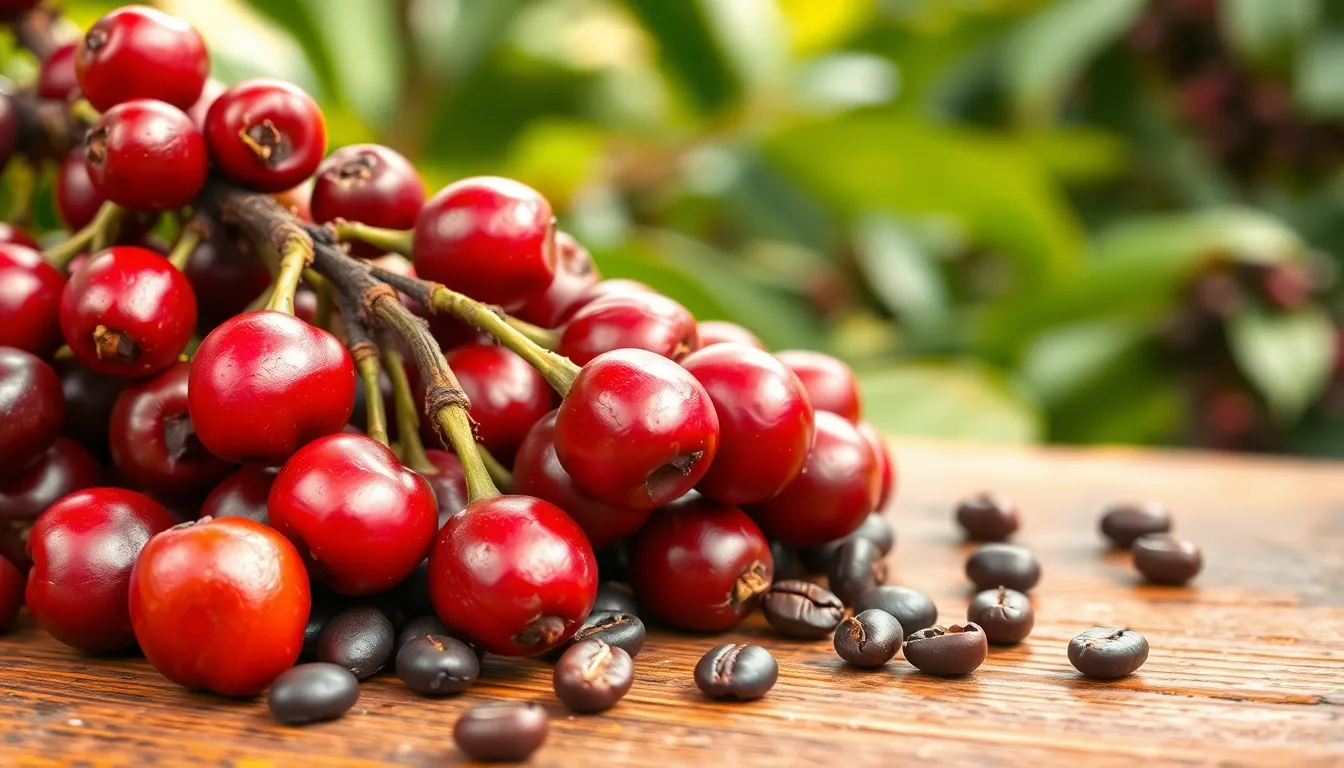
Fermenting coffee beans involves a complex biochemical process that fundamentally transforms the flavor profile of your coffee. After harvesting, coffee cherries are depulped, leaving beans coated with a sugar-rich mucilaginous layer that undergoes controlled microbial breakdown in exact temperature and pH conditions.
The Role of Microorganisms
Microorganisms drive coffee fermentation by breaking down the mucilage surrounding coffee beans through enzymatic action. Exact yeasts like Saccharomyces cerevisiae and Kluyveromyces marxianus work alongside bacterial species including Klebsiella, Erwinia, and Bacillus to degrade the sticky coating. These microbes secrete pectinases that break down complex carbohydrates, effectively removing residues from the beans. Carbon dioxide produced during this process creates pressure around the beans, helping them absorb flavors from surrounding coffee juices. Modern innovations like the Koji process introduce specialized fungi that unlock additional sugars and produce unique compounds such as glutamate, improving sweetness, aroma, and complexity beyond what traditional fermentation methods can achieve.
Chemical Changes During Fermentation
Chemical transformations during coffee fermentation significantly alter the bean’s composition and sensory qualities. The breakdown of mucilage polysaccharides into fermentable sugars and organic acids modifies the biochemical makeup of the beans. This enzymatic and microbial activity increases acidity while developing critical flavor precursors that contribute to coffee’s distinctive aromatic profile. The carefully controlled environment supports beneficial microbial growth while suppressing unwanted microorganisms, directly influencing the development of desirable flavor compounds. Fermentation stops precisely when sugars in the mucilage are consumed but before alcohol production begins, ensuring optimal flavor balance. These chemical changes establish the foundation for the coffee’s final taste characteristics, which are further developed during subsequent drying and roasting processes.
Traditional Coffee Fermentation Methods
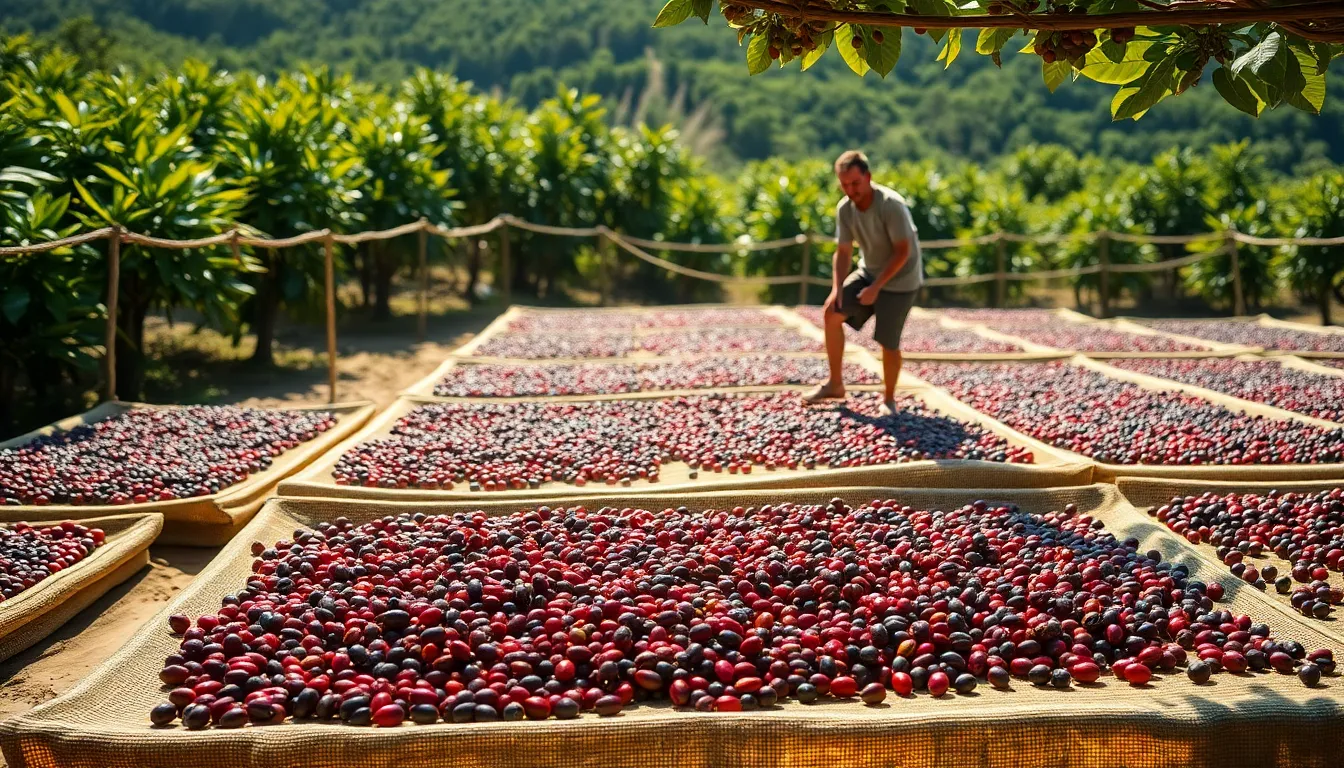
Coffee fermentation traditions have evolved over centuries, with two primary methods emerging as standard practices across coffee-growing regions. These techniques fundamentally alter the bean’s flavor profile through distinct biological processes.
Dry Fermentation Process
Dry fermentation, also called natural processing, involves fermenting the entire coffee cherry with all its components intact. Fresh cherries are spread across raised beds in direct sunlight and turned regularly to ensure even drying and prevent mold growth. Throughout this process, natural sugars within the cherry undergo fermentation, infusing the beans with complex, fruit-forward flavors. This method thrives in regions with limited water access, particularly Ethiopia, where it originated centuries ago. Coffee beans processed through dry fermentation develop distinctive fruity and wine-like characteristics, often exhibiting prominent blueberry, strawberry, and raspberry notes. The extended contact between the bean and its surrounding fruit material creates deeper flavor complexity compared to other methods.
Wet Fermentation Process
Wet fermentation begins with mechanical depulping to remove the cherry skin and pulp, leaving only the seeds covered in mucilage. These seeds are then submerged in water tanks for controlled fermentation lasting between 18-36 hours, though some producers extend this period up to 72 hours for exact flavor development. During this anaerobic process, producers carefully monitor pH and temperature to ensure fermentation progresses correctly without developing off-flavors or alcohol. Carbon dioxide pressure builds inside sealed tanks, enabling the beans to absorb flavors from the mucilage. Once fermentation completes, the beans undergo thorough washing to remove any remaining mucilage before drying.
Advanced wet processing includes additional steps like soaking the washed beans in clean water to further refine flavors. Some producers employ mechanical demucilaging using rotating drums as an alternative to traditional fermentation. Extended controlled fermentation under precise conditions increases desirable floral and fruity compounds while developing important flavor precursors such as amino acids and organic acids, which enhance coffee complexity during the roasting phase.
| Process | Method | Fermentation Medium | Flavor Profile | Common Regions |
|---|---|---|---|---|
| Dry (Natural) | Whole cherry allowed to dry | On raised beds, natural sugars | Fruity, winey, berry-like flavors | Ethiopia, water-scarce areas |
| Wet (Washed) | Pulp removed, seeds fermented | Submerged in water tanks | Clean, bright, floral and fruity | Various coffee-growing regions |
Innovative producers have begun experimenting with adding koji fungus during fermentation to unlock additional sugars and enhance sweetness and aroma, demonstrating how coffee fermentation techniques continue to evolve and develop.
Modern and Experimental Fermentation Techniques
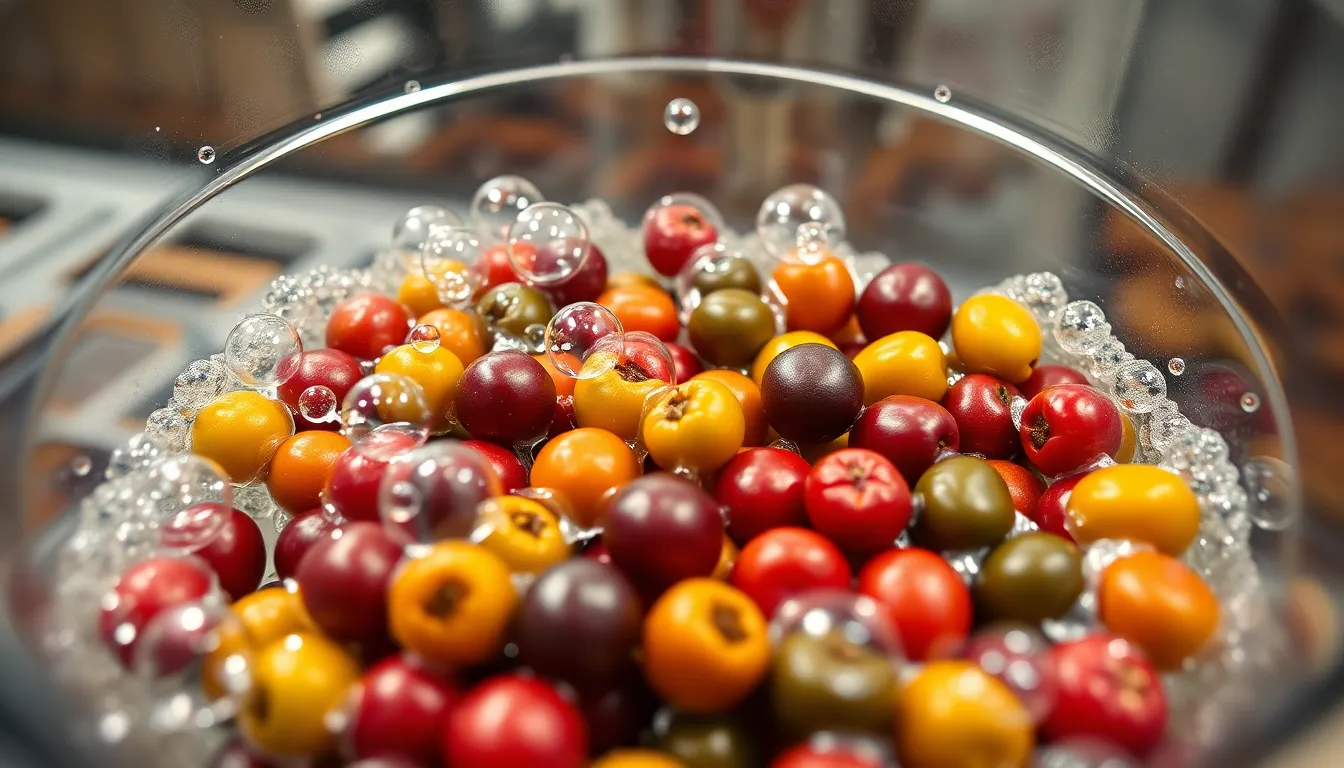
Traditional coffee fermentation has evolved dramatically in recent years, with innovative approaches now allowing producers to create distinctive flavor profiles that weren’t previously possible. These experimental techniques involve carefully controlling the fermentation environment to influence microbial activity and the resulting chemical transformations in coffee beans.
Anaerobic Fermentation
Anaerobic fermentation transforms coffee flavor by creating a low-oxygen environment that dramatically alters the microbial network during processing. Fresh coffee cherries are sealed in containers where oxygen is gradually displaced by carbon dioxide generated during fermentation. This oxygen-deprived setting encourages exact microbial species to thrive, breaking down fruit tissue and releasing unique flavor precursors not found in traditional fermentation methods. The controlled environment intensifies fruity and fermented notes, producing complex flavor profiles with distinctive character. Coffee producers carefully monitor this process, adjusting variables like temperature and duration to optimize the sensory qualities of their beans.
Carbonic Maceration
Carbonic maceration borrows techniques from winemaking to create coffee with exceptional flavor complexity and distinctive profiles. This specialized form of anaerobic fermentation involves placing whole coffee cherries in sealed tanks filled with carbon dioxide, creating a completely oxygen-free environment. Inside this setting, the cherries undergo intracellular fermentation before pulping, promoting unique biochemical reactions that develop wine-like, fruity, and floral notes impossible to achieve through conventional processing. Forward-thinking producers leverage carbonic maceration as part of their experimental toolkit to differentiate their coffee offerings in the specialty market. The resulting beans often exhibit enhanced sweetness, vibrant acidity, and aromatic complexity that command premium prices from discerning coffee enthusiasts.
How Fermentation Affects Coffee Flavor Profiles
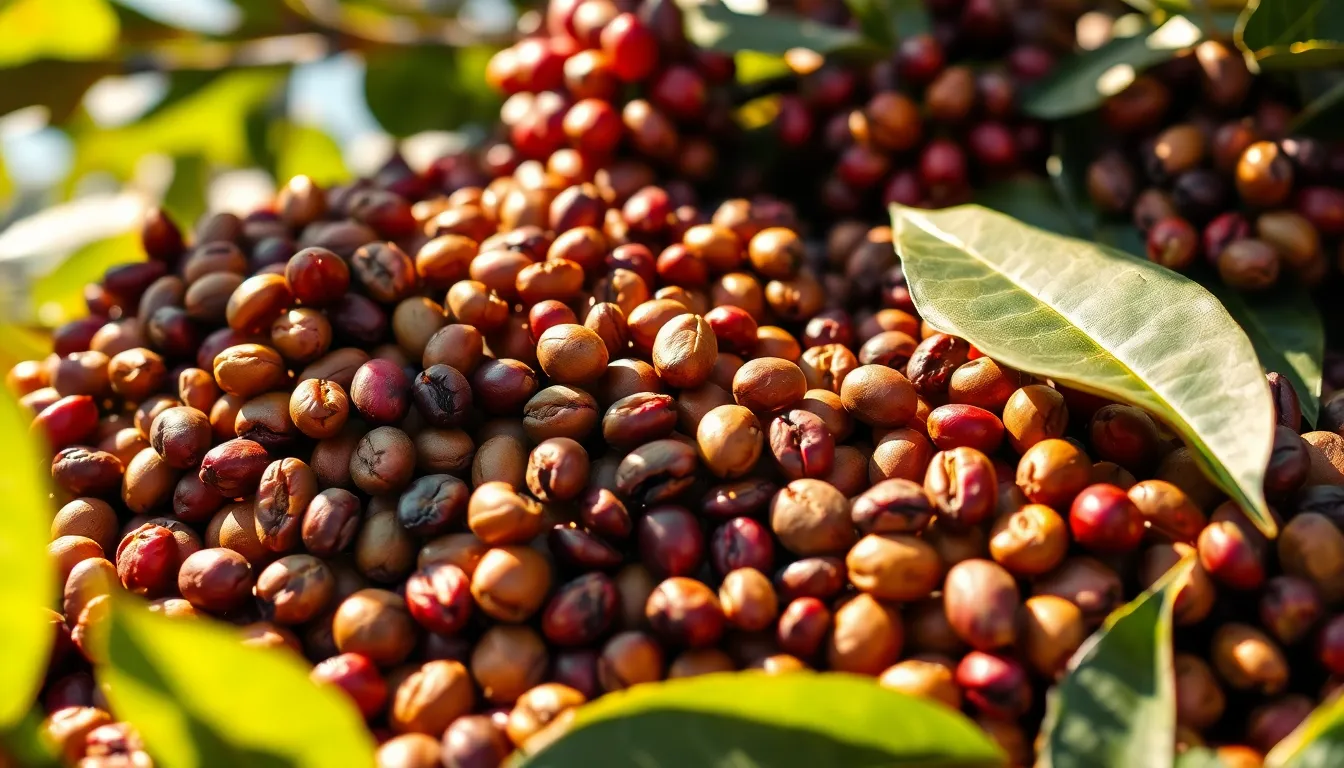
Fermentation transforms coffee beans by altering their chemical composition through controlled microbial activity. This critical process involves yeasts and bacteria breaking down the mucilage surrounding the beans, releasing compounds that significantly influence the final cup characteristics.
Acidity and Sweetness
The breakdown of mucilage during fermentation fosters the development of organic acids like lactic and citric acids, improving your coffee’s brightness and complexity. This process particularly shines in washed coffees, creating that vibrant, clean acidity with distinct citrus or berry notes commonly found in high-altitude varieties. Fermentation also amplifies sweetness by breaking down sugars, especially in honey processing methods where some mucilage remains on the bean during drying. These extended fermentation periods result in richer sweetness profiles featuring caramel, honey, stone fruit, and chocolate notes that add depth to your cup.
Body and Complexity
Fermentation contributes significantly to the body and complexity of your coffee through microbial metabolites that generate diverse flavor compounds. Natural processing, where the entire cherry ferments with intact pulp, develops bold fruit-forward characteristics such as berry, tropical fruit, and wine-like notes that create a fuller mouthfeel and more complex flavor experience. The interaction between the coffee bean’s own metabolic processes and environmental stress during fermentation alters its metabolomic profile, producing unique flavor outcomes in the final product. Controlled fermentation enhances desirable traits while poor management can introduce off-flavors like moldiness or chemical notes, highlighting the importance of precision in this crucial stage of coffee processing. Innovative methods such as anaerobic fermentation continue expanding the range of possible flavor profiles, offering exotic and distinctive taste experiences for coffee enthusiasts.
Fermenting Coffee at Home

Fermenting coffee beans at home transforms your coffee experience by developing complex flavors through controlled microbial activity. This hands-on process lets you customize the flavor profile of your beans before roasting and brewing.
Equipment Needed
Creating your home coffee fermentation setup requires minimal specialized equipment. You’ll need fresh coffee cherries or freshly depulped coffee beans (also called parchment coffee) as your starting material. A large container or tank with a lid works perfectly for the fermentation process, especially if you’re exploring anaerobic fermentation techniques. Clean water is essential throughout the process to maintain proper hygiene and prevent unwanted contamination. For separating the beans during washing, a fine mesh sieve or colander proves invaluable. A proper drying surface such as a rack or tray ensures even drying after fermentation. Coffee enthusiasts looking for more precise control might consider investing in a pH meter to monitor the fermentation progress.
Step-by-Step Process
The home coffee fermentation journey begins with careful selection and sorting of your coffee cherries. Choose only ripe cherries and remove any underripe or floating ones that could negatively impact your batch. Quality at this stage directly influences your final cup quality.
Depulping follows if you’re starting with whole cherries. Remove the outer skin and pulp either manually or with a depulping tool to expose the mucilage-covered beans. This mucilage layer contains the sugars and compounds that drive the fermentation process.
Fermentation takes place when you submerge the mucilage-covered beans in clean water in your container. The process typically lasts 18-24 hours depending on ambient temperature and your desired flavor development. During this period, natural enzymes and microbes break down the mucilage, releasing sugars and acids that infuse the beans with distinctive flavors. Anaerobic fermentation in sealed containers creates pressure from CO₂ buildup, helping flavors absorb deeper into the beans. Monitor the process by smell and touch—the beans become slippery as the mucilage loosens—or use a pH meter for more precise control.
Washing thoroughly after fermentation removes all loosened mucilage from the beans. Use clean water and your sieve to ensure all residue is removed, preventing any off-flavors from developing.
Drying completes the process by spreading the clean beans on your drying rack in a sunny or well-ventilated area. Turn the beans regularly to achieve even drying until they reach 10-12% moisture content. This critical step stabilizes the beans and preserves the flavors developed during fermentation.
Coffee fermentation offers exciting variations to explore at home. The natural process allows whole cherries to ferment and dry intact, creating intensely fruity and complex flavors. The honey process, where skin is removed but mucilage remains, produces varying levels of sweetness and fruitiness depending on how much mucilage is left. Adventurous coffee lovers might even experiment with koji fermentation, using this Japanese fungus to unlock sugars and enhance coffee aroma.
Home coffee fermentation revolves around controlling time and maintaining cleanliness to achieve desirable flavors without spoilage. Each batch becomes an opportunity to discover how fermentation variables alter your coffee’s taste profile before you even begin roasting.
Notable Coffee-Producing Regions and Their Fermentation Styles
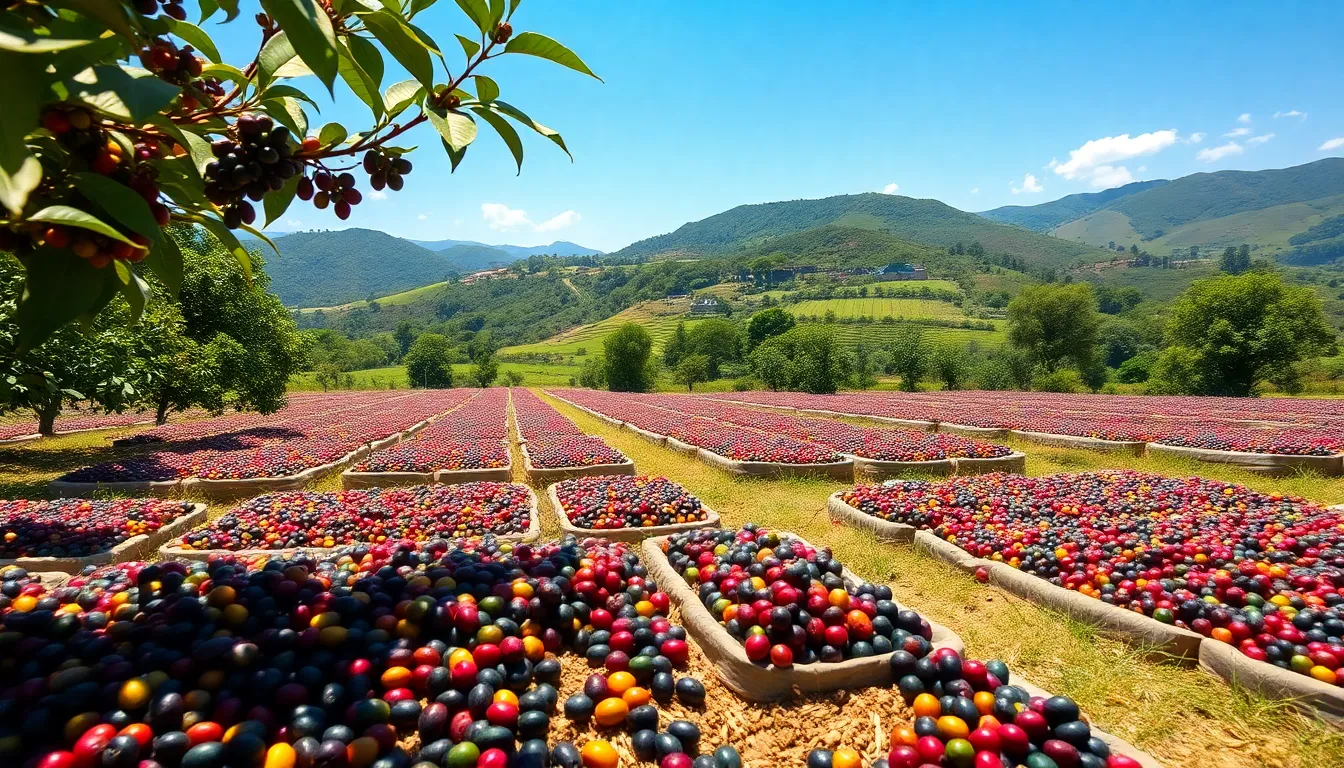
Coffee fermentation techniques vary dramatically across different regions, creating distinct flavor signatures that reflect local traditions and innovations. Each area’s unique approach to fermentation contributes to the rich diversity of coffee profiles available worldwide.
Ethiopia (Natural Process)
Ethiopian coffee producers predominantly use the natural (dry) process, fermenting the entire coffee cherry with its skin, pulp, and mucilage intact. Fresh cherries are spread on raised beds under the sun, requiring consistent turning to ensure even drying and prevent mold formation. This traditional method creates deeply fruity flavor profiles with signature blueberry, strawberry, and raspberry notes complemented by molasses-like sweetness. The extended contact between the bean and its fruity exterior during fermentation infuses the coffee with these distinctive berry characteristics that Ethiopian coffees are celebrated for.
Central and South America (Washed and Honey Process)
Latin American coffee regions have perfected the washed processing technique, which begins by mechanically removing the cherry pulp. The beans, still coated with mucilage, are then fermented in water tanks before being thoroughly washed and dried. This meticulous process yields coffee with clean, bright acidity and enhanced clarity of flavor that showcases the bean’s inherent characteristics.
The honey process represents a middle ground approach popular throughout Central America. Processors remove the cherry skin and pulp while leaving varying amounts of mucilage on the bean during fermentation. This method comes in three distinct variations:
- Yellow honey: Features minimal mucilage and shorter fermentation periods, producing fruity cups with clean finishes
- Red honey: Maintains moderate mucilage levels during fermentation, developing sweeter profiles with more pronounced fruit notes
- Black honey: Preserves maximum mucilage for extended fermentation, creating complex, winey flavors with boozy undertones
Other Regions and Innovations
Cutting-edge fermentation techniques continue to emerge across coffee-producing regions globally. Anaerobic fermentation in sealed tanks allows producers to precisely control oxygen levels and pressure, developing unique flavor compounds not possible with traditional methods. Extended fermentation periods under controlled conditions increase floral and fruity notes through the production of exact microbial metabolites like lactic acid and mannitol.
The innovative Koji process introduces a specialized fungus to coffee fermentation, unlocking otherwise inaccessible sugars from the bean structure. This technique enhances complexity, aroma, and sweetness while developing distinctive structural notes in the final cup.
| Region | Fermentation Style | Flavor Characteristics |
|---|---|---|
| Ethiopia | Natural (dry) | Berry-forward, fruity, molasses sweetness |
| Central/South America | Washed | Clean, bright, transparent terroir expression |
| Central/South America | Honey (yellow, red, black) | Progressively sweeter and more complex with increased mucilage retention |
| Global Innovators | Koji, Anaerobic | Enhanced aromatics, complex acidity, unique flavor compounds |
These regional approaches to fermentation highlight how geographical traditions and modern experimentation continue to expand coffee’s flavor potential, creating distinctive taste experiences that reflect both place of origin and processing ingenuity.
Challenges and Considerations in Coffee Fermentation
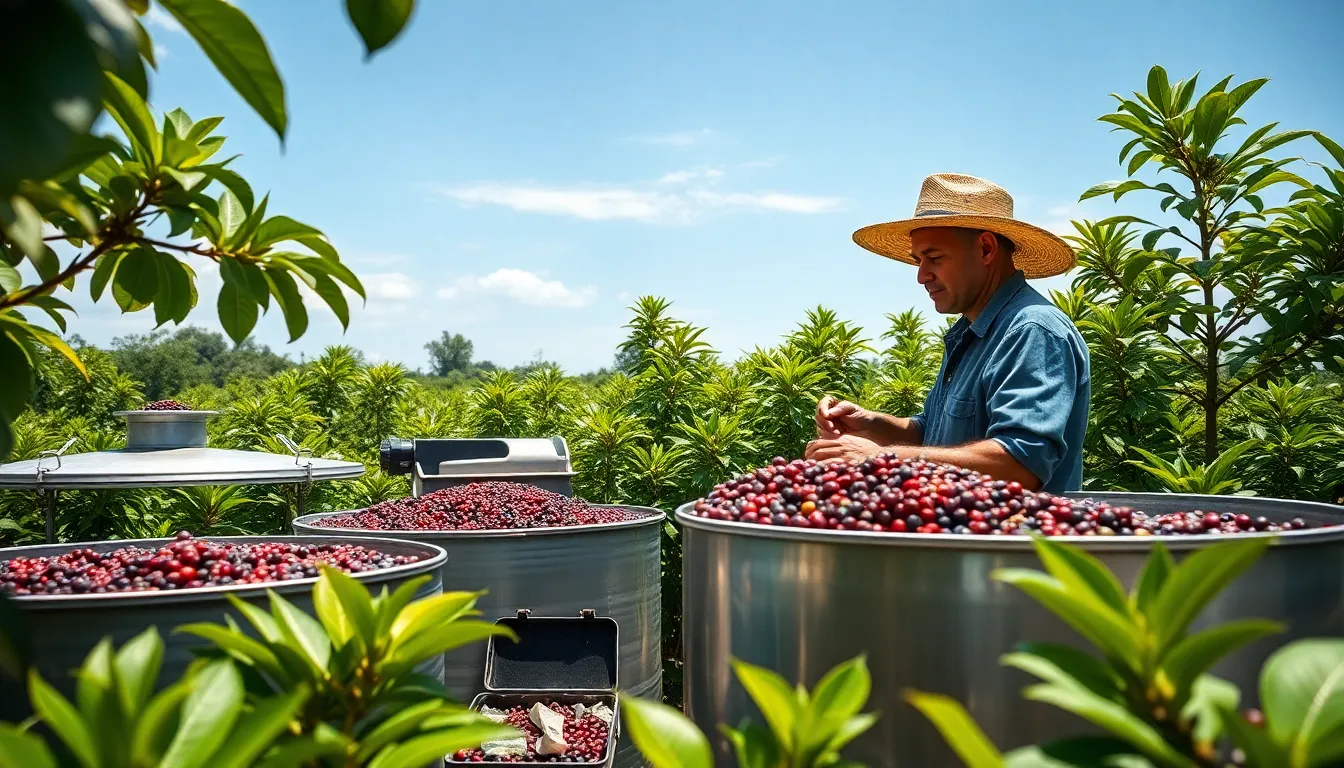
Coffee fermentation presents several critical challenges that producers must navigate to achieve optimal flavor profiles. Temperature control stands as one of the most important hurdles, as even minor fluctuations can dramatically alter the microbial activity and resulting flavors. Maintaining precise temperature conditions throughout the 18-24 hour fermentation period requires constant monitoring and adjustment, especially in regions with variable climate patterns.
pH levels create another layer of complexity in the fermentation process. Continuous monitoring of acidity becomes essential to prevent over-fermentation, which occurs when the pH drops too low and produces unpleasant vinegary or alcoholic notes. Many experienced producers test pH regularly, stopping the fermentation when sugars in the mucilage are consumed but before alcohol production begins.
Microbial management introduces additional variables that affect coffee quality. The natural microbial community—including yeasts like Saccharomyces cerevisiae and various bacteria—transforms the coffee’s flavor profile through enzymatic action, but unwanted contamination can ruin an entire batch. Maintaining clean fermentation tanks and equipment helps minimize this risk while promoting beneficial microbial activity.
Environmental factors such as humidity and altitude significantly impact fermentation outcomes. Coffee cherries fermented in high-humidity environments typically require shorter fermentation times compared to drier climates, where the process may extend to ensure complete mucilage breakdown. These environmental influences create regional variations in fermentation practices across different coffee-producing areas.
Process standardization remains elusive even though technological advances. Innovative methods like using Koji fungus spores show tremendous promise by enzymatically unlocking sugars and improving complexity, sweetness, and aroma. But, these techniques demand greater innovation and knowledge to standardize across different production scales and environments.
CO2 build-up during fermentation contributes to the infusion of flavors into the beans but requires careful management. Excessive gas accumulation can create pressure problems in sealed fermentation vessels, while insufficient CO2 may result in inadequate flavor development. Producers must strike a delicate balance to harness this natural process for optimal results.
The length of fermentation dramatically affects the final product, with longer periods potentially producing more complex flavors at the risk of introducing off-notes. Natural process fermentation can extend up to 30 days, allowing for extended microbial interaction with the bean, while wet processing typically limits fermentation to 24 hours to maintain cleaner flavor profiles.
Conclusion
Fermenting coffee beans stands at the fascinating intersection of science art and tradition. As you’ve discovered it’s this crucial process that transforms ordinary beans into extraordinary coffee experiences with distinctive flavor profiles.
Whether you’re exploring Ethiopian naturals with their berry notes or experimenting with cutting-edge anaerobic techniques at home the fermentation process offers endless possibilities for flavor development.
By understanding the biochemical foundations and regional variations you can appreciate why your morning cup tastes the way it does. The next time you enjoy a perfectly balanced coffee remember that fermentation is the hidden hero behind those complex flavors you love.
The industry of coffee fermentation continues to evolve offering both producers and enthusiasts new frontiers to explore in the pursuit of the perfect cup.
Frequently Asked Questions
What is coffee fermentation?
Coffee fermentation is a process where natural microorganisms break down the sugary mucilage surrounding coffee beans after harvest. This biochemical process transforms raw coffee cherries into the beans used for brewing, as yeasts and bacteria convert sugars into acids, alcohols, and aromatic compounds that significantly influence the final flavor profile of the coffee.
How long does coffee fermentation take?
Coffee fermentation typically takes between 12 hours and several days. The duration varies based on environmental factors such as temperature and humidity, the specific fermentation method being used, and the desired flavor profile. Longer fermentation periods may produce more complex flavors but require careful monitoring to avoid off-notes.
What are the main types of coffee fermentation methods?
The main coffee fermentation methods are dry (natural) processing, where the whole cherry ferments; wet processing, where depulped beans ferment in water tanks; and honey processing, a middle-ground approach. Modern techniques include anaerobic fermentation (low-oxygen environment) and carbonic maceration (borrowed from winemaking), which create unique flavor profiles.
How does fermentation affect coffee flavor?
Fermentation significantly impacts coffee flavor by developing organic acids that enhance brightness and complexity, amplifying sweetness with notes of caramel and honey, and contributing to body through microbial metabolites. Different methods produce distinct flavor profiles—dry processing creates fruit-forward flavors, wet processing yields clean, bright tastes, and experimental techniques can develop wine-like characteristics.
Can I ferment coffee at home?
Yes, you can ferment coffee at home with minimal equipment: fresh coffee cherries or depulped beans, a fermentation container, clean water, and a drying surface. The process involves selecting ripe cherries, depulping them, and submerging the beans in water for 18-24 hours. Cleanliness and monitoring are essential to achieve desirable flavors without spoilage.
What challenges exist in coffee fermentation?
Key challenges in coffee fermentation include maintaining precise temperature control, monitoring pH levels to prevent over-fermentation, managing environmental factors like humidity and altitude, and handling CO2 build-up during the process. Standardizing innovative techniques across different production scales and determining optimal fermentation length also present significant challenges for producers.
How do different regions approach coffee fermentation?
Ethiopian producers typically use dry processing for fruity, berry-noted coffees. Central and South American regions excel in washed processing for clean, bright profiles. Each region’s approach reflects local traditions, climate conditions, and available resources. Some regions are now adopting innovative techniques like anaerobic fermentation and koji processing to create distinctive flavor experiences.
What microorganisms are involved in coffee fermentation?
The primary microorganisms in coffee fermentation include yeasts like Saccharomyces cerevisiae and various bacteria that break down the mucilage through enzymatic action. These microbes transform the beans’ chemical composition by developing acids, alcohols, and aromatic compounds. Some innovative producers are even experimenting with introducing specific cultures, such as koji fungus, to enhance particular flavor characteristics.
What is anaerobic coffee fermentation?
Anaerobic coffee fermentation is a modern technique that creates a low-oxygen environment during the fermentation process. This altered environment changes microbial activity and produces intensified fruity and fermented notes in the coffee. The method often involves sealed tanks or vacuum-sealed bags to limit oxygen exposure, resulting in unique flavor profiles with enhanced sweetness and complexity.
Does fermentation affect caffeine content in coffee?
Fermentation primarily affects the flavor compounds in coffee rather than caffeine content. The caffeine remains largely stable during the fermentation process. The significant changes occur in the development of acids, sugars, and aromatic compounds that contribute to the coffee’s flavor profile, while the stimulant properties of the coffee remain essentially unchanged.

